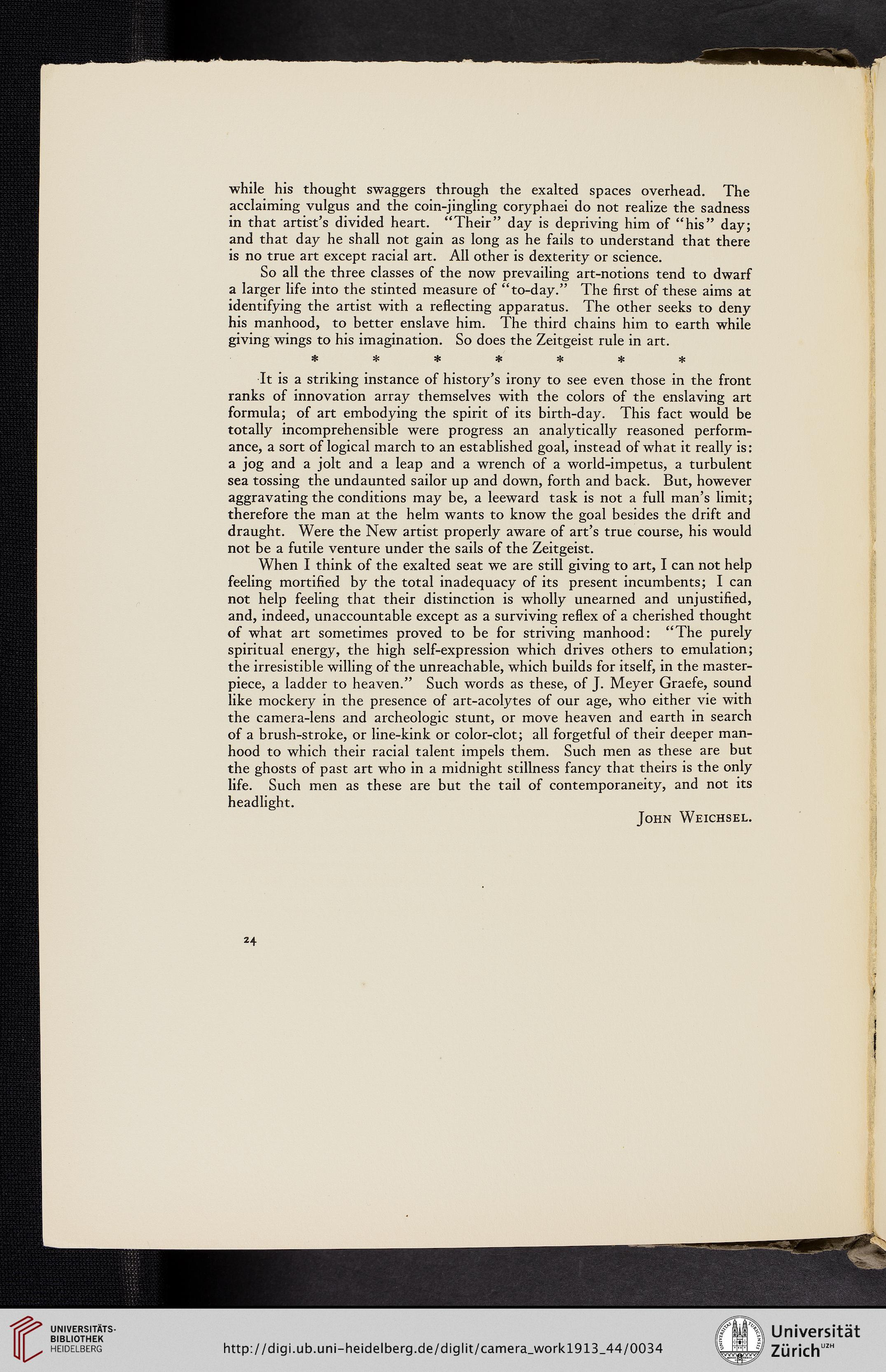Für diese Seite ist auch eine manuell angefertigte Transkription bzw. Edition verfügbar. Bitte wechseln Sie dafür zum Reiter "Transkription" oder "Edition".
while his thought swaggers through the exalted spaces overhead. The
acclaiming vulgus and the coin-jingling coryphaei do not realize the sadness
in that artist’s divided heart. “Their” day is depriving him of “his” day;
and that day he shall not gain as long as he fails to understand that there
is no true art except racial art. All other is dexterity or science.
So all the three classes of the now prevailing art-notions tend to dwarf
a larger life into the stinted measure of “to-day.” The first of these aims at
identifying the artist with a reflecting apparatus. The other seeks to deny
his manhood, to better enslave him. The third chains him to earth while
giving wings to his imagination. So does the Zeitgeist rule in art.
*******
It is a striking instance of history’s irony to see even those in the front
ranks of innovation array themselves with the colors of the enslaving art
formula; of art embodying the spirit of its birth-day. This fact would be
totally incomprehensible were progress an analytically reasoned perform-
ance, a sort of logical march to an established goal, instead of what it really is:
a jog and a jolt and a leap and a wrench of a world-impetus, a turbulent
sea tossing the undaunted sailor up and down, forth and back. But, however
aggravating the conditions may be, a leeward task is not a full man’s limit;
therefore the man at the helm wants to know the goal besides the drift and
draught. Were the New artist properly aware of art’s true course, his would
not be a futile venture under the sails of the Zeitgeist.
When I think of the exalted seat we are still giving to art, I can not help
feeling mortified by the total inadequacy of its present incumbents; I can
not help feeling that their distinction is wholly unearned and unjustified,
and, indeed, unaccountable except as a surviving reflex of a cherished thought
of what art sometimes proved to be for striving manhood: “The purely
spiritual energy, the high self-expression which drives others to emulation;
the irresistible willing of the unreachable, which builds for itself, in the master-
piece, a ladder to heaven.” Such words as these, of J. Meyer Graefe, sound
like mockery in the presence of art-acolytes of our age, who either vie with
the camera-lens and archeologic stunt, or move heaven and earth in search
of a brush-stroke, or line-kink or color-clot; all forgetful of their deeper man-
hood to which their racial talent impels them. Such men as these are but
the ghosts of past art who in a midnight stillness fancy that theirs is the only
life. Such men as these are but the tail of contemporaneity, and not its
headlight.
John Weichsel.
24
acclaiming vulgus and the coin-jingling coryphaei do not realize the sadness
in that artist’s divided heart. “Their” day is depriving him of “his” day;
and that day he shall not gain as long as he fails to understand that there
is no true art except racial art. All other is dexterity or science.
So all the three classes of the now prevailing art-notions tend to dwarf
a larger life into the stinted measure of “to-day.” The first of these aims at
identifying the artist with a reflecting apparatus. The other seeks to deny
his manhood, to better enslave him. The third chains him to earth while
giving wings to his imagination. So does the Zeitgeist rule in art.
*******
It is a striking instance of history’s irony to see even those in the front
ranks of innovation array themselves with the colors of the enslaving art
formula; of art embodying the spirit of its birth-day. This fact would be
totally incomprehensible were progress an analytically reasoned perform-
ance, a sort of logical march to an established goal, instead of what it really is:
a jog and a jolt and a leap and a wrench of a world-impetus, a turbulent
sea tossing the undaunted sailor up and down, forth and back. But, however
aggravating the conditions may be, a leeward task is not a full man’s limit;
therefore the man at the helm wants to know the goal besides the drift and
draught. Were the New artist properly aware of art’s true course, his would
not be a futile venture under the sails of the Zeitgeist.
When I think of the exalted seat we are still giving to art, I can not help
feeling mortified by the total inadequacy of its present incumbents; I can
not help feeling that their distinction is wholly unearned and unjustified,
and, indeed, unaccountable except as a surviving reflex of a cherished thought
of what art sometimes proved to be for striving manhood: “The purely
spiritual energy, the high self-expression which drives others to emulation;
the irresistible willing of the unreachable, which builds for itself, in the master-
piece, a ladder to heaven.” Such words as these, of J. Meyer Graefe, sound
like mockery in the presence of art-acolytes of our age, who either vie with
the camera-lens and archeologic stunt, or move heaven and earth in search
of a brush-stroke, or line-kink or color-clot; all forgetful of their deeper man-
hood to which their racial talent impels them. Such men as these are but
the ghosts of past art who in a midnight stillness fancy that theirs is the only
life. Such men as these are but the tail of contemporaneity, and not its
headlight.
John Weichsel.
24



